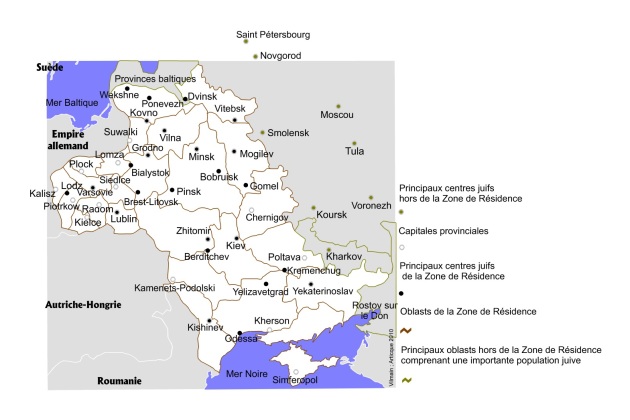The emancipation crisis (1880-1914)
The 1880s found the drive for emancipation and assimilation mired in crisis. Within the Russian Empire, emancipation, which had come to be seen as an inescapable prospect, faltered upon the assassination of Tsar Alexander II that was followed, between 1881 and 1884, by a wave of pogroms assorted with a range of restrictive measures, to wit the numerus clausus controlling admissions to the university in 1887. In Central and Western Europe the emancipation was increasingly brought into question as modern anti-Semitism gathered speed. Willelm Marr published his Der Weg zum Siege des Germanenthums über das Judenthum (The Way to Victory of Germanism over Judaism), in 1879, whereupon the first anti-Semitic leagues appeared in Germany and Austria. In France, the Paris Bourse crash of 1882, the publication of Édouard Drumont's La France juive (Jewish France) then the Panama Canal Scandal in 1893 fostered an anti-Semitic climate that would culminate in the Dreyfus Affair in 1898-99. In Vienna an anti-Semitic candidate was elected major in 1895.
Meanwhile, within Judaism, the questioning of an assimilation considered detrimental to Judaic survival was gaining credence. It would however be a misinterpretation to imagine that this mood would primarily affect those who had benefited most from emancipation and had more frequently mixed with society at large – men. Indeed not: the critics of assimilation within Judaism tracked the cause of all of Judaism's troubles back to women. The “bourgeois Jewish woman” was painted, notably in the Zionist press, as lascivious, frivolous, materialist. She had forsworn her foremost duties, namely the upkeep of a Jewish character in her home on the one hand and the fostering of love for her people and faith on the other. Worse still, she was suspected of being drawn to Christianity. The image of the Jewish salonnières of late 18th century Prussia met with an almost universal opprobrium best voiced by historian Heinrich Graetz[1] . These salonnières, Dorothea Mendelssohn, Henriette Herz and Rahel Varnhagen best known among them, were women from the enlightened Jewish bourgeoisie. Perhaps one hundred of them chose to convert, leading Graetz to hold them up as the very symbol of female unfaithfulness. Later historians would rather see there the upshot of the lack of opportunities Judaism offered towards women's fulfilment. Whatever the case, in the German Empire, during the 1870s, only 7% of converts were women, the percentage would rise to 40% in the run up to WWI without ever exceeding that of male conversions – though the situation is somewhat different in Germany's Polish territories.
Meanwhile, at its most “sophisticated”, anti-Semitic thought rested both on the medieval myth of Jewish male menses and on the more recent writings of converts on the theme of the Jew as a sexually inverted being. Otto Weininger, a young Viennese Jew converted to Protestantism, helped revive this vile accusation in a 1903 book titled Sex and Character, very well received in anti-Semitic circles. He proposed that each individual was made up in varying proportions of male and female substance, whence he drew his explanation of lesbianism – or over-masculine women – and male homosexuality – or over-feminine men. In the prevailingly racialist context of the times, Weininger's theory was applied wholesale to the group: Jewish men are feminine and Jewish women are masculine. Weininger committed suicide the year his essay came out and many see in him to this day the archetypal self-hating Jew.
The anti-Semitic myth of Jewish inversion stresses the issue of the home as the traditional location of the Jewish man studying the Torah while his wife ventures out to sustain the family. This crude construct, for all that it endured in some shtetls[2] of theRussian Empire's Pale of settlements, is paradoxically at the antithesis of the bourgeois model to which the vast majority of West-European Jewish families subscribed. This did not stop anti-Semites from complementing the picture with a few physiological observations: the Jewish man had a female tone of voice – or psychological: the Jewish man was like women, bereft of any logical powers – which speaks volumes about the Jew hatred and wholesale misogyny prevailing at the end of the 19th century. This said, while it is especially the femininity of the Jewish “male” that is made much of, all Jewish women must equally consider, in their decisions the eventuality of the equally vile accusation of masculinity. It hardly needs saying that “performing” – after Judith Butler[3] 's formula – both the roles of Jewess and woman was a daily high-wire act.
This was bound to affect some career choices. There would not be, at first, many women in Western and Central Europe, seeking their emancipation through work. When it happened, upon the opening of German universities to women at the turn of the 20th century, opting for medicine or the law was not seen as favourably as a career in education. As for claiming such roles as were hitherto masculine within a synagogue that remained the shining expression of Judaism, it hardly seemed opportune given the general mood. This also went for politics. To get involved, say in socialism was a risky choice liable to incur the family and the community's wrath compounded with the displeasure with that community of society at large. The worst possible decision was of course to declare one's feminism, a category that appeared at the end of the 1890s. However, whereas some young women from the Jewish middle classes balked at a career plan deemed masculine, such reluctance had little currency in Russia where medical skills for instance amounted to a passport to the rest of the world.







